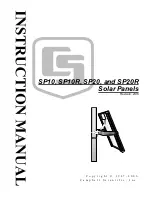
SIM02E-010C+E
5
ELECTRICAL OUTPUT AND THERMAL CHARACTERISTICS
Rated electrical characteristics are within ±10 percent of the indicated values of Voc, Isc and +5/-0 percent of Pmax, under STC
(standard test conditions) (irradiance of 1,000 W/m
2
, AM 1.5 spectrum, and a cell temperature of 25 °C (77 °F)).
Table-1. Electrical characteristics (at STC)
Model
name
Maximum
Power
(Pmax)
Tolerance
Open-Curcuit
Voltage
(Voc)
Short-Circuit
Current
(Isc)
Voltage at point
of max. Power
(Vmpp)
Current at point
of max. Power
(Impp)
Maximum
sy stem voltage
Over-Current
Protection
Class for
protec tion
against
elec ric al
shoc k
Maximum
series
configuration(*)
NU-JD545
545W
+5%/-0%
50,54V
13,73A
41,83V
13,03A
1.500V
25A
Ⅱ
24
NU-JD550
550W
+5%/-0%
50,70V
13,81A
42,02V
13,09A
1.500V
25A
Ⅱ
24
* The maximum series number of modules depends on the local conditions. T hese values are calculated under the condition of Voc at -40 °C.
Under normal conditions, a PV module is likely to experience conditions that produce more current and/or voltage than reported
at Standard Test Conditions. Accordingly, the values of Isc and Voc marked on this PV module should be multiplied by a factor
of 1.25 when determining component voltage ratings, conductor current ratings, fuse sizes and size of controls connected to the
PV module output.
The PV module has been qualified in an environmental temperature range of -40 °C to +40 °C and up to 100 % relative humidity
as well as rain, and the altitude up to 2,000 m in accordance with IEC61730.
Class for protection against electric shock
This PV module is classified as “Class
Ⅱ
” according to
IEC61730. These PV modules are intended for installation
where general user access and contact to insulated live parts is
anticipated.
FIRE RATING
This PV module is rated as “Fire safety class C” according to
IEC61730-2:2004 or UL790.
























